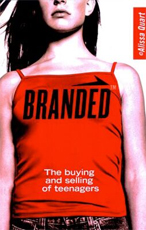Today's Y generation, those born between 1979 and 1995, have been bombarded with ad campaigns and products from the cradle on. Many of them are now what marketers call "trend slaves." American teenagers spent $155 billion in "discretionary income" in 2000 buying clothes, CDs, and makeup. Alissa Quart, a graduate of Brown University and the Columbia School of Journalism, has written a eye-opening and soul-shaking overview of the multidimensional activities of companies to win over these youth with their products and branding. She is convinced that "the personae, self-images, ambitions, and values of young people in the United States have been seriously distorted by the commercial frenzy surrounding them." To be popular at school, teens have to wear the coolest brands.
Many upscale girls and boys have become unpaid teen consultants. Corporations and ad agencies use these trend spotters to market products to their peers. Turning point rituals, such as bar mitzvah parties, are targeted. Buying into brands is a coming-of-age ritual. A recent ad for McDonald's said: "There will be a first step, a first word and, of course, a first French fry." Equally ominous is the branding going on in schools where, for example, 150 school districts in 29 states have Pepsi or Coke contracts. The continued privatization of schools regards education as a franchise for merchandising. More and more families and communities are organizing against this development.
Through savvy assessments of such teen movies as Clueless and She's All That, Quart sets the stage for an examination of the popularity of youthful makeovers. In the year 2000, breast augmentation was the third most popular procedure for people under 18, according to The American Society of Plastic Surgeons. Add this to the popularity of liposuction and kid-produced anorexia Web logs, and you begin to see how teens are altering their bodies in lockstep response to the fashion industry standard of "thinspiration." Boys, of course, are into weight lifting and bulging biceps. This hard-hitting work vividly conveys the frightening undertow of the buying and selling of teenagers.
